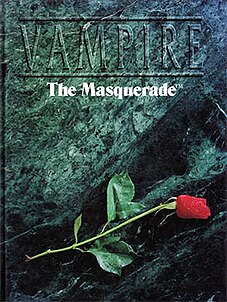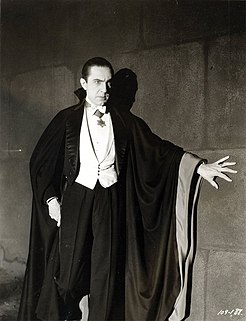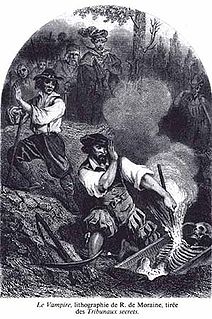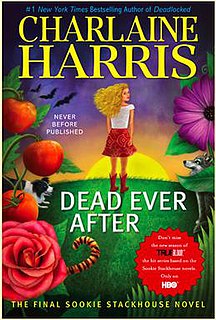
The chupacabra or chupacabras is a legendary creature in the folklore of parts of the Americas, with its first purported sightings reported in Puerto Rico. The name comes from the animal's reported habit of attacking and drinking the blood of livestock, including goats.

In folklore, a werewolf or occasionally lycanthrope is a human with the ability to shapeshift into a wolf, either purposely or after being placed under a curse or affliction and especially on the night of a full moon. Early sources for belief in this ability or affliction, called lycanthropy, are Petronius (27–66) and Gervase of Tilbury (1150–1228).

Porphyria is a group of diseases in which substances called porphyrins build up, negatively affecting the skin or nervous system. The types that affect the nervous system are also known as acute porphyria, as symptoms are rapid in onset and last a short time. Symptoms of an attack include abdominal pain, chest pain, vomiting, confusion, constipation, fever, high blood pressure, and high heart rate. The attacks usually last for days to weeks. Complications may include paralysis, low blood sodium levels, and seizures. Attacks may be triggered by alcohol, smoking, hormonal changes, fasting, stress, or certain medications. If the skin is affected, blisters or itching may occur with sunlight exposure.

Vampire: The Masquerade is a tabletop role-playing game created by Mark Rein-Hagen and released in 1991 by White Wolf Publishing as the first of several Storyteller System games for its World of Darkness setting line. It is set in a fictionalized "gothic-punk" version of the modern world, where players assume the roles of vampires, who are referred to as "Kindred", and deal with their night-to-night struggles against their own bestial natures, vampire hunters and each other.

The vampire squid is a small cephalopod found throughout temperate and tropical oceans in extreme deep sea conditions. Unique retractile sensory filaments justify the vampire squid's placement in its own order, Vampyromorphida, as it shares similarities with both octopuses and squid. As a phylogenetic relict, it is the only known surviving member of its order. The first specimens were collected on the Valdivia Expedition and they were originally described as an octopus in 1903 by German teuthologist Carl Chun, but later assigned to a new order together with several extinct taxa.

Vampire bats are bats whose food source is blood, a dietary trait called hematophagy. Three extant bat species feed solely on blood: the common vampire bat, the hairy-legged vampire bat, and the white-winged vampire bat. All three species are native to the Americas, ranging from Mexico to Brazil, Chile, Uruguay and Argentina.

The Saga of Darren Shan is a young adult 12-part book series written by Darren Shan about the struggle of a boy who has become involved in the world of vampires. As of October 2008, the book has been published in 33 countries around the world, in 30 different languages. A film based on the first three books in the series was released in theatres on October 23, 2009. Blackstone Audio has also released CD recordings of all 12 books in the series, read by Ralph Lister.

The common vampire bat is a small, leaf-nosed bat native to the Americas. It is one of three extant species of vampire bat, the other two being the hairy-legged and the white-winged vampire bats. The common vampire bat mainly feeds on the blood of livestock, approaching its prey at night while they are sleeping. It uses its razor-sharp teeth to cut open the skin of its hosts and laps up their blood with its long tongue.

In the fictional world of the television series Buffy the Vampire Slayer and its spin-off series Angel, a vampire is a unique variety of demon that can only exist on the earthly plane by inhabiting and animating a human corpse. In Fray, a Buffy comic book spin-off set about a century in the future, vampires are also called lurks.
In the Anita Blake: Vampire Hunter series of novels, author Laurell K. Hamilton has developed a detailed mythology. Her series is an alternate history that assumes that the supernatural is real, and that vampires, lycanthropes, and other supernatural beings live alongside humans in a society that otherwise resembles 21st century North America.

The lightning bird or impundulu or thekwane is a creature in the folklore of the tribes of South Africa including the Pondo, the Zulu and the Xhosa. The impundulu takes the form of a black and white bird, the size of a person, which is said to summon thunder and lightning with its wings and talons. It is a vampiric creature associated with witchcraft, often the servant or familiar of a witch or witch doctor, which attacks the witch's enemies. It is said to have an insatiable appetite for blood. Sometimes it takes the form of a beautiful young man who seduces women.

Blood & Water was a 2003 five-issue horror comic book limited series written by Judd Winick and illustrated by Tomm Coker, with covers by Brian Bolland. It was published by Vertigo Comics from March to July, 2003, with cover dates of May to September, 2003.
The Peuchen is a creature from the Mapuche mythology and Chilote mythology pertaining to southern Chile, a much feared shapeshifting creature which could instantly change into animal form.

Count Dracula is the title character of Bram Stoker's 1897 gothic horror novel Dracula. He is considered to be both the prototypical and the archetypal vampire in subsequent works of fiction. He is also depicted in the novel to be the origin of werewolf legends. Some aspects of the character are believed to have been inspired by the 15th-century Wallachian Prince Vlad the Impaler, who was also known as Dracula, and Sir Henry Irving, an actor for whom Stoker was a personal assistant.

Legends of vampires have existed for millennia; cultures such as the Mesopotamians, Hebrews, ancient Greeks, and Romans had tales of demonic entities and blood-drinking spirits which are considered precursors to modern vampires. Despite the occurrence of vampire-like creatures in these ancient civilizations, the folklore for the entity we know today as the vampire originates almost exclusively from early 18th-century Southeastern Europe, particularly Transylvania as verbal traditions of many ethnic groups of the region were recorded and published. In most cases, vampires are revenants of evil beings, suicide victims, or witches, but can also be created by a malevolent spirit possessing a corpse or by being bitten by a vampire itself. Belief in such legends became so rife that in some areas it caused mass hysteria and even public executions of people believed to be vampires.

The Southern Vampire Mysteries, also known as The True Blood Novels and The Sookie Stackhouse Novels, is a series of books written by bestselling author Charlaine Harris. The first installment, Dead Until Dark (2001), won the Anthony Award for Best Paperback Mystery in 2001 and later served as the source material for the HBO drama series True Blood (2008–2014). The book series has been retronymed the True Blood Series upon reprinting, to capitalize on the television adaptation.
"Pilot" is the pilot episode of The CW television series, The Vampire Diaries, as well as the first episode of the series. It originally aired on Thursday, September 10, 2009. The teleplay was written by Kevin Williamson and Julie Plec and it directed by Marcos Siega.














